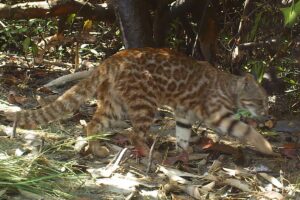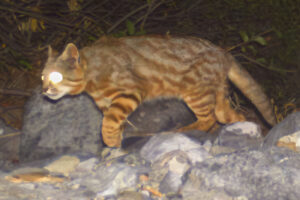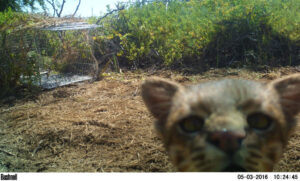 For several decades, researchers have been debating the taxonomy of the Pampas cat (Leopardus colocolo), mainly because of the little that we know about this small wild cat. Some authors, such as García-Perea (1994), and subsequently Wozencraft (2005), based on morphological data, recognized three polytypic species: Leopardus colocolo (with 2 subspecies), L. braccatus (also with 2 subspecies), and L. pajeros, (with 7 subspecies). However, others authors (e.g. Johnson et al. 1999; Sunquist and Sunquist 2009), based in genetic data, recognized only one polytypic species, L. colocolo, with several subspecies. Later on, Kitchener et al. (2017) with the intention of clarifying and summarizing all the information, recommended that because of lack of congruity between morphological and genetic studies, we should still consider Pampas cat as a single species with 7 sub species.
For several decades, researchers have been debating the taxonomy of the Pampas cat (Leopardus colocolo), mainly because of the little that we know about this small wild cat. Some authors, such as García-Perea (1994), and subsequently Wozencraft (2005), based on morphological data, recognized three polytypic species: Leopardus colocolo (with 2 subspecies), L. braccatus (also with 2 subspecies), and L. pajeros, (with 7 subspecies). However, others authors (e.g. Johnson et al. 1999; Sunquist and Sunquist 2009), based in genetic data, recognized only one polytypic species, L. colocolo, with several subspecies. Later on, Kitchener et al. (2017) with the intention of clarifying and summarizing all the information, recommended that because of lack of congruity between morphological and genetic studies, we should still consider Pampas cat as a single species with 7 sub species.
However, Nascimento et al. (2020) clarify the situation about the taxonomy of the Pampas cat, by combining the broadest morphological coverage of this species to date with molecular data and ecological niche models. They conclude that there are actually five Pampas cat species in South America with no sub species, which are morphologically diagnosable based on skin and skull traits, have evolved in distinct climatic niche spaces and were recovered in molecular species delimitation. These species are: Desert Pampas cat Leopardus garleppi, Savanna Pampas cat Leopardus braccatus, Pampa cat Leopardus munoai, Colocolo cat Leopardus colocola, and Pajeros cat Leopardus pajeros.
Ecology
Pampas cats are solitary felids, terrestrial, and hunt mainly on the ground. Studies in Peru, Argentina and Bolivia showed that is it a cathemeral species, which it means they can be active any time of day. However they tend to be more nocturnal.
Pampas cats feed on a variety of rodents, game birds and occasionally on lizards. They can feed on guinea pigs, mountain vizcachas, house mice, moorhens, gulls, and tinamous. Also, they have been known to take flamingos and ground-dwelling birds and has been observed raiding penguin nests for eggs and chicks in Patagonia.
According to a few studies conducted on Desert Pampas cat in the Peruvian Desert and in the Argentinian Andes, its home range can vary between 3.3 to 43.4 km2. On the other hand, the Savanna Pampas cat in Brazil has a home range between 19.47 and 27.7 km2.
Reproduction
Much of the reproductive biology of the Pampas Cat is unknown. From captive records, the period of heat is between 5 – 7 days, the gestation is 80 – 85 days, and litters are said to contain one to three kittens. The breeding season of the few Pampas cats in captivity is from April to July. They have lived over 16 years in captivity. Unlike some of the other small felids they are reputedly aggressive and not responsive to taming.
Threats
- Habitat loss and degradation due to oil extraction, agricultural cropland and livestock grazing
- Retaliation killing for preying on poultry
- Road accidents
- Attacks by domestic dogs
- Disease transmission from domestic, free-ranging and feral dogs an cats
- Hunting for cultural purposes mostly in the high Andes
- Pet trade
Desert Pampas cat Leopardus garleppi,
- Head Body Length: 58 – 65 cm
- Tail Length: 26 – 32 cm
- Weight: 1.8 – 5 kg
- Height: 33 – 38 cm
- Population: Decreasing and Vulnerable
Habitat: This species is distributed from southern Colombia to northern Chile and Argentina, including Ecuador, Peru, and Bolivia, from sea level to approximately 5000 metres above sea level. It can be found in a wide variety of habitats, such as desert, dry forest, inter Andean valleys and across the Andes, and even in croplands close to human settlements. The populations of the desert and dry forest tend to be smaller than the population from the Andes.
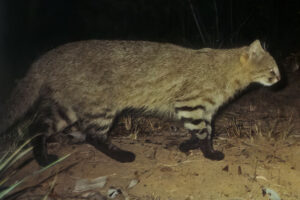 Savanna Pampas cat Leopardus braccatus
Savanna Pampas cat Leopardus braccatus
- Head Body Length: 68.2 cm
- Tail Length: 25.9 cm
- Weight: 3.9 kg
- Height: 28.7 cm
- Population: Decreasing and Vulnerable
Habitat: The species is distributed mainly in Brazil, but can be also found in Paraguay and eastern Bolivia. Inhabit open areas, such as Cerrado, Pantanal, the savannas of Beni and the Chiquitano dry forest.
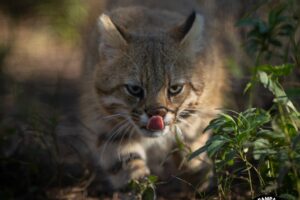 Pampa cat Leopardus munoai
Pampa cat Leopardus munoai
There is no information about its body measurements.
Population: Decreasing and Critically Endangered
Habitat: This species is distributed mainly in Uruguay and inhabits the fields of the Uruguayan savanna, a subtropical native grassland ecoregion, the extreme south of Brazil (state of Rio Grande do Sul – restricted area to the Pampas biome), as well as a small area in northeastern Argentina. This field seems to have been historically isolated in this region, possibly due to geographical barriers such as the Plata River to the south, the Paraná/Paraguay rivers to the west and the Atlantic Forest to the north.
Colocolo cat Leopardus colocola
- Head Body Length: 78 – 80 cm
- Tail Length: 33 – 35 cm
- Weight: 3.5 – 7 kg
- Height: 36 – 38 cm
- Population: Decreasing and Vulnerable
Habitat: Leopardus colocola is restricted to Central Chile on the western slope of the Andes, from sea level to 2400 metres above sea level. It is found in coastal deserts, Mediterranean forests, woodlands and shrublands of the Chilean Matorral. There are also records on forestry plantations and vineyards.
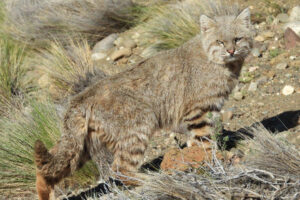 Pajeros cat Leopardus pajeros
Pajeros cat Leopardus pajeros
- Head Body Length: 70.5 – 73 cm
- Tail Length: 23 – 24.5 cm
- Weight: 3.5 – 4.3 kg
- Height: NA
- Population: Decreasing and Vulnerable
Habitat: This species is distributed from northern Argentina to southern Chile and Argentina, on the eastern slope of the Andes. It occurs in the Chaco Dry Forest, in the Espinal and in the Patagonia region. Its highest altitudinal range is unclear because an overlap of its distribution with the Desert Pampas cat (L. garleppi), but it can be found from sea level.
Pampas Cat Working Group (PCWG)
 The Pampas Cat Working Group (PCWG) is a network of conservationists and researchers seeking to protect the Pampas cat complex and its habitat throughout its distribution in South America. To do this, they work together with the local communities where this small wild cat is found, to reduce the threats that are facing. The PCWG develops conservation projects in the five latest recognized pampas cat species.
The Pampas Cat Working Group (PCWG) is a network of conservationists and researchers seeking to protect the Pampas cat complex and its habitat throughout its distribution in South America. To do this, they work together with the local communities where this small wild cat is found, to reduce the threats that are facing. The PCWG develops conservation projects in the five latest recognized pampas cat species.
To mitigate the threats that are affecting pampas cat populations, and to study its ecology and conservation status, the PCWG implement the following strategies:
- Building and improvement of anti-predation chicken coops
- Vaccination and sterilization campaigns for domestic and feral dogs and cats
- Installation of wildlife crossing signs and awareness campaigns on wildlife roadkill
- Installation of automatic waterers in areas with water shortages, like the dry forest
- Rehabilitation and release of small wild felines
- Environmental education activities with adults and schoolchildren in the rural areas where we work.
- Painting of murals about the Pampas cat, other small wild cats and rural communities.
- Creation of comic bocks for children
- Monitoring pampas cat populations using camera traps
You can check their Annual Report 2023 here.
See also Peruvian Desert Cat Project
